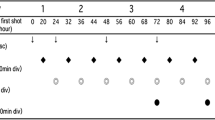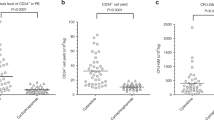Abstract
In an attempt to improve the complete remission (CR) rates and to prolong the remission duration especially in elderly patients >50 years of age, we have used a combination chemotherapy of idarubicin (10 mg/m2 IV×3 days), cytarabine (AraC, 100 mg/m2 CIVI×7d), and etoposide (100 mg/m2×5 days) in combination with granulocyte colony-stimulating factor (G-CSF) priming [5 mg/kg SQ day 1 until absolute neutrophil count (ANC) recovery] for remission induction. Responding patients received two consolidation courses of idarubicin, AraC, and etoposide, followed by a late consolidation course of intermediate-dose AraC (600 mg/m2 IV every 12 h×5 days) and amsacrine (60 mg/m2 IV×5 days). A total of 112 patients (57 male/55 female) with a median age of 58 years (range: 22–75) have been entered and are evaluable for response: 19 refractory anemia with excess of blast cells in transformation (RAEB-T), 84 acute myeloid leukemia (AML) evolving from myelodysplastic syndrome (MDS), and 9 secondary AML after chemotherapy/radiotherapy. The overall CR rate was 62%, partial remission (PR) rate 10%, treatment failure 16%, and early death rate 12%. The CR rate was higher in patients ≤60 years (68 vs 55%), mainly due to a lower early death rate (5 vs 21%, p<0.001). After a median follow-up of 58 months, the median overall survival is 14.5% and median duration of relapse-free survival 8 months. After 60 months, the probability of CR patients to still be in CR and alive is 16% (20% in patients ≤60 years and 13% in patients >60 years), while the probability of overall survival is 12% (15% in patients ≤60 years and 9% in patients >60 years). Compared to our previous trial (AML-MDS Study 01-92) which was done with identical chemotherapy but no G-CSF priming in 110 patients with RAEB-T, AML after MDS, or secondary AML (identical median age, age range, and distribution of subtypes), the CR rate in all patients, as well as CR rate, overall survival, and relapse-free survival in patients >60 years have significantly been improved. Thus, intensive chemotherapy with G-CSF priming is both well tolerated and highly effective for remission induction in these high-risk patients.



Similar content being viewed by others
References
Aivado M, Rong A, Germing U, Gattermann N, Kobbe G, Rieth C, Haas R, Aul C (2000) Long-term remission after intensive chemotherapy in advanced myelodysplastic syndromes is generally associated with restoration of polyclonal haemopoiesis. Br J Haematol 110:884–886
Bernasconi C, Alessandrino EP, Bernasconi P, Bonfichi M, Lazzarino M, Canevari A, Castelli G, Brusamolino E, Pagnucco G, Castagnola C (1998) Randomized clinical study comparing aggressive chemotherapy with or without G-CSF support for high-risk myelodysplastic syndromes or secondary acute myeloid leukaemia evolving from MDS. Br J Haematol 102:678–683
Bernstein SH, Brunetto VL, Davey FR, Wurster-Hill D, Mayer RJ, Stone RM, Schiffer CA, Bloomfield CD (1996) Acute myeloid leukemia-type chemotherapy for newly diagnosed patients without antecedent cytopenias having myelodysplastic syndrome as defined by French–American–British criteria: a cancer and leukemia group B study. J Clin Oncol 14:2486–2494
Dombret H (1998) Granulocyte colony-stimulating factor in combination with intensive chemotherapy in the treatment of acute myeloid leukemia. Leuk Res 22:1137–1142
Dombret H, Chastang C, Fenaux P, Reiffers J, Bordessoule D, Bouabdallah R, Mandelli F, Ferrant A, Auzanneau G, Tilly H (1995) A controlled study of recombinant human granulocyte colony-stimulating factor in elderly patients after treatment for acute myelogenous leukemia. AML Cooperative Study Group. N Engl J Med 332:1678–1683
Estey EH, Kantarjian HM, O’Brien S, Kornblau S, Andreeff M, Beran M, Pierce S, Keating M (1995) High remission rate, short remission duration in patients with refractory anemia with excess blasts (RAEB) in transformation (RAEB-t) given acute myelogenous leukemia (AML)-type chemotherapy in combination with granulocyte-CSF (G-CSF). Cytokines Mol Ther 1:21–28
Fenaux P, Morel P, Rose C, Lai JL, Jouet JP, Bauters F (1991) Prognostic factors in adult de novo myelodysplastic syndromes treated by intensive chemotherapy. Br J Haematol 77:497–501
Gajewski JL, Ho WG, Nimer SD, Hirji KF, Gekelman L, Jacobs AD, Champlin RE (1989) Efficacy of intensive chemotherapy for acute myelogenous leukemia associated with a preleukemic syndrome. J Clin Oncol 7:1637–1645
Ganser A, Heil G, Seipelt G, Hofmann WK, Fischer JT, Langer W, Brockhaus W, Kolbe K, Ittel TH, Brack N, Fuhr HG, Knuth P, Hoffken K, Bergmann L, Hoelzer D (2000) Intensive chemotherapy with idarubicin, ara-C, etoposide, and m-AMSA followed by immunotherapy with interleukin-2 for myelodysplastic syndromes and high-risk acute myeloid leukemia (AML). Ann Hematol 79:30–35
Gardin C, Chaibi P, de Revel T, Rousselot P, Turlure P, Miclea JM, Nedellec G, Dombret H (1997) Intensive chemotherapy with idarubicin, cytosine arabinoside, and granulocyte colony-stimulating factor (G-CSF) in patients with secondary and therapy-related acute myelogenous leukemia. Club de Reflexion en Hematologie. Leukemia 11:16–21
Greenberg P, Cox C, LeBeau MM, Fenaux P, Morel P, Sanz G, Sanz M, Vallespi T, Hamblin T, Oscier D, Ohyashiki K, Toyama K, Aul C, Mufti G, Bennett J (1997) International scoring system for evaluating prognosis in myelodysplastic syndromes. Blood 89:2079–2088
Heil G, Hoelzer D, Sanz MA, Lechner K, Liu Yin JA, Papa G, Noens L, Szer J, Ganser A, O’Brien C, Matcham J, Barge A (1997) A randomized, double-blind, placebo-controlled, phase III study of filgrastim in remission induction and consolidation therapy for adults with de novo acute myeloid leukemia. The International Acute Myeloid Leukemia Study Group. Blood 90:4710–4718
Hoelzer D, Seipelt G (1995) Granulocyte colony-stimulating factor and granulocyte-macrophage colony-stimulating factor in the treatment of myeloid leukemia. Curr Opin Hematol 2:196–203
Hoyle CF, de Bastos M, Wheatley K, Sherrington PD, Fischer PJ, Rees JK, Gray R, Hayhoe FG (1989) AML associated with previous cytotoxic therapy, MDS or myeloproliferative disorders: results from the MRC’s 9th AML trial. Br J Haematol 72:45–53
Kaplan E, Meier P (1958) Nonparametric estimation from incomplete observations. J Am Stat Assoc 53:457–481
Keating MJ, McCredie KB, Benjamin RS, Bodey GP, Zander A, Smith TL, Freireich EJ (1981) Treatment of patients over 50 years of age with acute myelogenous leukemia with a combination of rubidazone and cytosine arabinoside, vincristine, and prednisone (ROAP). Blood 58:584–591
Lowenberg B, van Putten W, Theobald M, Gmur J, Verdonck L, Sonneveld P, Fey M, Schouten H, de Greef G, Ferrant A, Kovacsovics T, Gratwohl A, Daenen S, Huijgens P, Boogaerts M (2003) Effect of priming with granulocyte colony-stimulating factor on the outcome of chemotherapy for acute myeloid leukemia. N Engl J Med 349:743–752
Michels SD, Saumur J, Arthur DC, Robison LL, Brunning RD (1989) Refractory anemia with excess of blasts in transformation hematologic and clinical study of 52 patients. Cancer 64:2340–2346
Ohno R, Tomonaga M, Kobayashi T, Kanamaru A, Shirakawa S, Masaoka T, Omine M, Oh H, Nomura T, Sakai Y (1990) Effect of granulocyte colony-stimulating factor after intensive induction therapy in relapsed or refractory acute leukemia. N Engl J Med 323:871–877
Oosterveld M, Muus P, Suciu S, Koller C, Verhoef G, Labar B, Wijermans P, Aul C, Fiere D, Selleslag D, Willemze R, Gratwohl A, Ferrant A, Mandelli F, Cortes J, de Witte T, Estey E (2002) Chemotherapy only compared to chemotherapy followed by transplantation in high risk myelodysplastic syndrome and secondary acute myeloid leukemia; two parallel studies adjusted for various prognostic factors. Leukemia 16:1615–1621
Ossenkoppele GJ, van der HB, Verhoef GE, Daenen SM, Verdonck LF, Sonneveld P, Wijermans PW, van der LJ, van Putten WL, Lowenberg B (1999) A randomized study of granulocyte colony-stimulating factor applied during and after chemotherapy in patients with poor risk myelodysplastic syndromes: a report from the HOVON Cooperative Group. Dutch–Belgian Hemato-Oncology Cooperative Group. Leukemia 13:1207–1213
Parker JE, Pagliuca A, Mijovic A, Cullis JO, Czepulkowski B, Rassam SM, Samaratunga IR, Grace R, Gover PA, Mufti GJ (1997) Fludarabine, cytarabine, G-CSF and idarubicin (FLAG-IDA) for the treatment of poor-risk myelodysplastic syndromes and acute myeloid leukaemia. Br J Haematol 99:939–944
Wattel E, De Botton S, Luc LJ, Preudhomme C, Lepelley P, Bauters F, Fenaux P (1997) Long-term follow-up of de novo myelodysplastic syndromes treated with intensive chemotherapy: incidence of long-term survivors and outcome of partial responders. Br J Haematol 98:983–991
de Witte T, Suciu S, Peetermans M, Fenaux P, Strijckmans P, Hayat M, Jaksic B, Selleslag D, Zittoun R, Dardenne M (1995) Intensive chemotherapy for poor prognosis myelodysplasia (MDS) and secondary acute myeloid leukemia (sAML) following MDS of more than 6 months duration. A pilot study by the Leukemia Cooperative Group of the European Organisation for Research and Treatment in Cancer (EORTC-LCG). Leukemia 9:1805–1811
de Witte T, Suciu S, Verhoef G, Labar B, Archimbaud E, Aul C, Selleslag D, Ferrant A, Wijermans P, Mandelli F, Amadori S, Jehn U, Muus P, Boogaerts M, Zittoun R, Gratwohl A, Zwierzina H, Hagemeijer A, Willemze R (2001) Intensive chemotherapy followed by allogeneic or autologous stem cell transplantation for patients with myelodysplastic syndromes (MDSs) and acute myeloid leukemia following MDS. Blood 98:2326–2331
Author information
Authors and Affiliations
Corresponding author
Rights and permissions
About this article
Cite this article
Hofmann, W.K., Heil, G., Zander, C. et al. Intensive chemotherapy with idarubicin, cytarabine, etoposide, and G-CSF priming in patients with advanced myelodysplastic syndrome and high-risk acute myeloid leukemia. Ann Hematol 83, 498–503 (2004). https://doi.org/10.1007/s00277-004-0889-0
Received:
Accepted:
Published:
Issue Date:
DOI: https://doi.org/10.1007/s00277-004-0889-0




